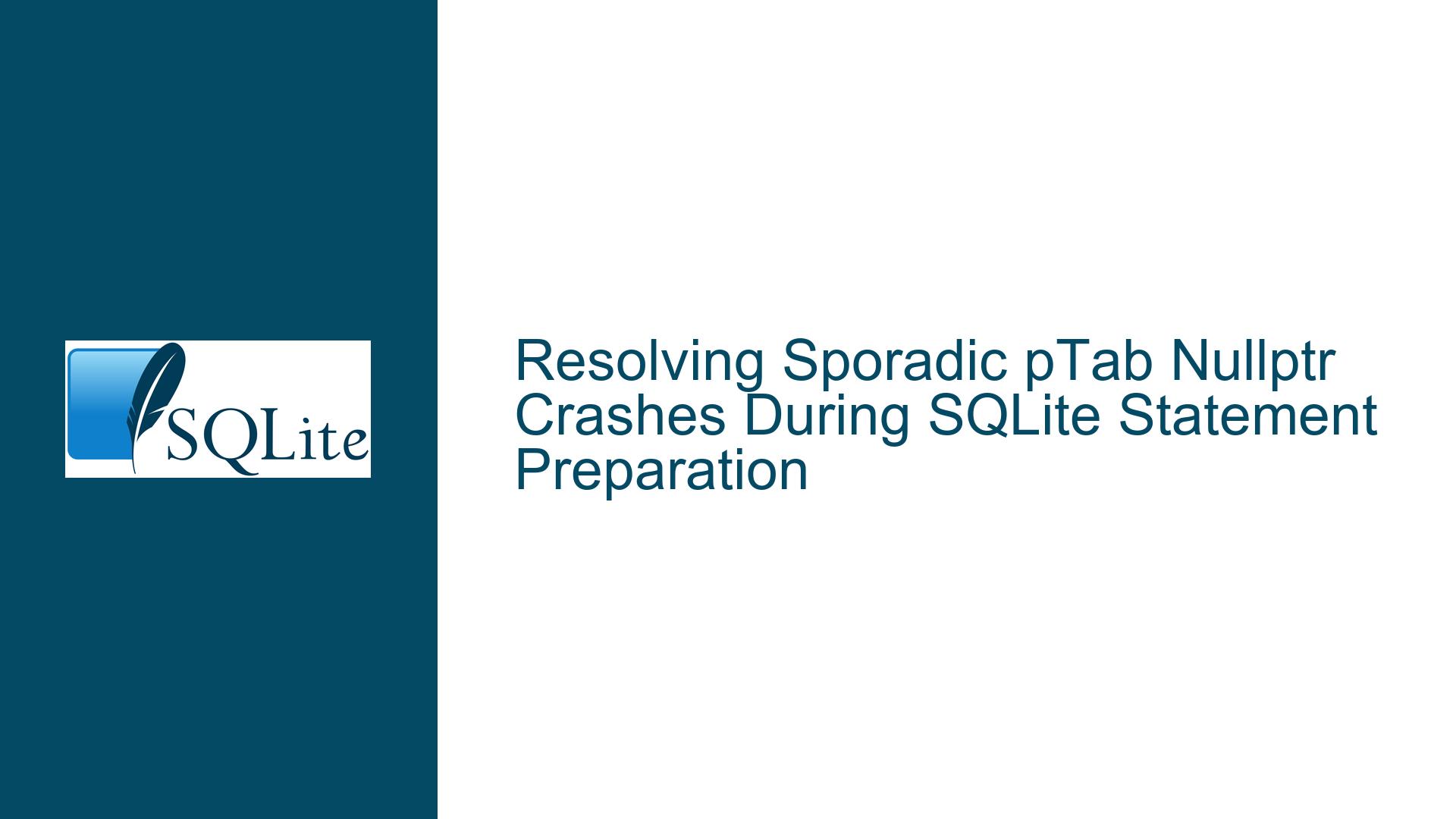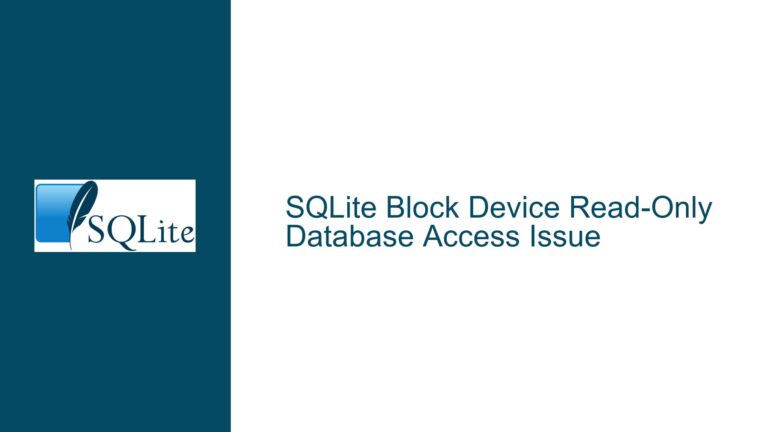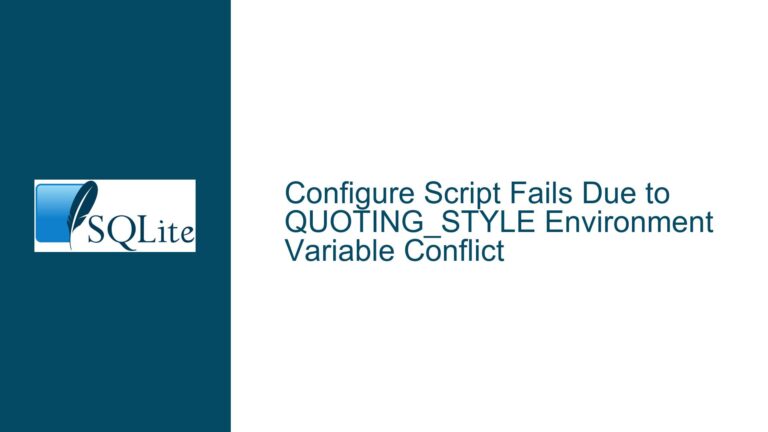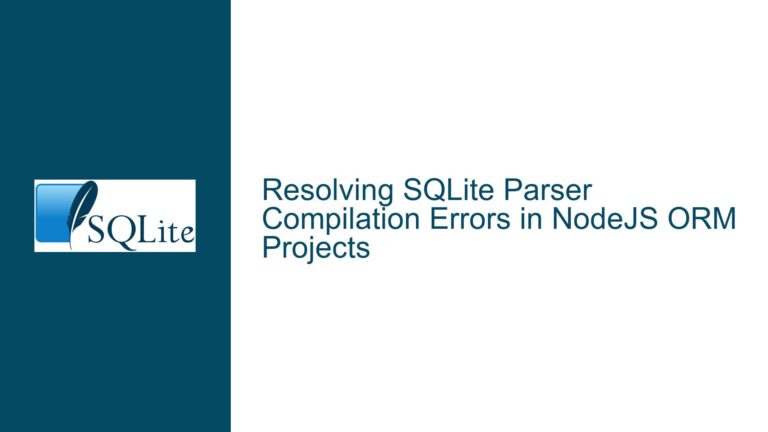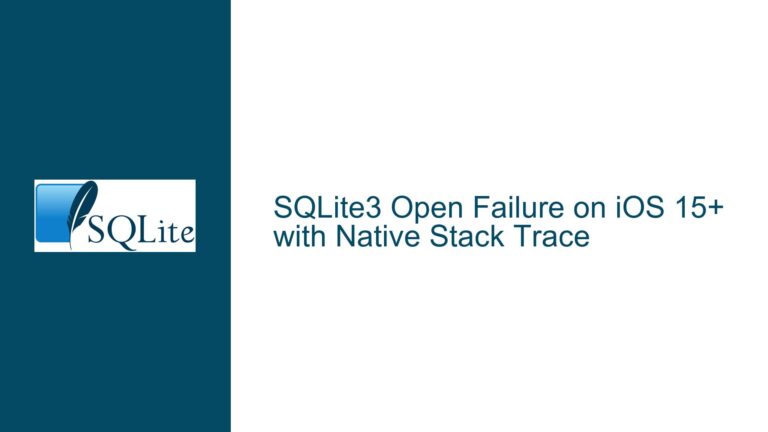Resolving Sporadic pTab Nullptr Crashes During SQLite Statement Preparation
Issue Overview: SQLite Crashes During Statement Preparation Due to Null pTab Pointer
Sporadic crashes during SQLite statement preparation involving a null pTab pointer in the lookupName function indicate a failure in resolving table names during query parsing. This manifests as an unhandled read access violation when SQLite attempts to dereference pTab, which is unexpectedly nullptr. The crash occurs even with simple queries like SELECT x FROM y, where table "y" appears valid. The inconsistency of the crash suggests an environmental or timing-related factor corrupting SQLite’s internal state during query preparation. Key components involved include SQLite’s parser, resolver, and schema validation logic. The resolver (lookupName) relies on schema data structures being intact, and a null pTab implies either missing schema metadata or corrupted memory references.
Possible Causes: Memory Corruption, Schema Race Conditions, and API Misuse
Memory Corruption in Client Application
Heap corruption caused by buffer overflows, use-after-free errors, double frees, or uninitialized memory access in the application can overwrite SQLite’s internal data structures. For example, a buffer overflow in unrelated application code might overwrite the Parse object or schema cache, causing pTab resolution to fail. SQLite’s lightweight design assumes correct memory management by the host application; even minor heap inconsistencies can propagate into SQLite’s operations.
Concurrent Schema Modifications Without Proper Locking
If the schema is modified (e.g., DROP TABLE y, ALTER TABLE) while a statement is being prepared, SQLite’s schema versioning may not atomically reflect changes across threads or processes. Although SQLite employs locks to prevent concurrent writes, improper transaction handling (e.g., not using BEGIN IMMEDIATE) in multi-threaded environments can lead to race conditions where the schema cache becomes invalid during resolution.
Incorrect Use of SQLite APIs
Reusing prepared statements across database connections, failing to reset or finalize statements, or closing database handles before associated statements are finalized can leave dangling pointers in SQLite’s internal structures. For instance, if a database connection is closed while a prepared statement is still active, subsequent operations on that statement may reference invalid memory.
Troubleshooting Steps, Solutions & Fixes: Isolation, Debugging, and Code Hardening
Step 1: Validate Application Memory Management
Use memory debugging tools to identify heap corruption. On Windows:
- Enable the Page Heap (
gflags.exe /i your_app.exe +hpa) to detect buffer overflows. - Use Visual Studio’s Memory Diagnostics (Debug → Windows → Memory) to inspect memory around
pTabduring crashes. - Run the application under Dr. Memory or Application Verifier to trace invalid memory accesses.
Reproduce the crash under these tools and analyze logs for heap inconsistencies unrelated to SQLite. For example, a write to an out-of-bounds array index in application code might corrupt SQLite’s sqlite3 object or schema hash tables.
Step 2: Ensure Schema Stability During Statement Preparation
Isolate schema modifications from query preparation:
- Wrap schema changes (
CREATE,DROP,ALTER) in explicit transactions withBEGIN IMMEDIATEto prevent concurrent access. - Use
sqlite3_db_mutexto serialize access to the database handle in multi-threaded code. - Verify that the schema exists and remains unmodified during the entire preparation lifecycle. For example, a
SELECTmight checksqlite3_schema_version()before and after preparation to detect mid-process schema changes.
Step 3: Audit SQLite API Usage
Ensure strict adherence to API rules:
- Finalize all prepared statements (
sqlite3_finalize) before closing their associated database connection. - Avoid sharing prepared statements across threads without mutex protection.
- Enable SQLite’s error logging via
sqlite3_config(SQLITE_CONFIG_LOG, ...)to capture warnings likeSQLITE_SCHEMA_ERROR, which indicate schema changes invalidating prepared statements.
Step 4: Enable SQLite Debugging Features
Compile SQLite with debugging options:
-DSQLITE_DEBUGenables internal consistency checks, such as validating the schema cache before resolution.-DSQLITE_ENABLE_EXPLAIN_COMMENTSadds diagnostic metadata to prepared statements, aiding in tracing resolver behavior.- Use
sqlite3_test_control(SQLITE_TESTCTRL_ASSERT)to trigger deliberate failures if invariants are violated.
Step 5: Reproduce Under Controlled Conditions
Minimize variables by creating a stripped-down test case:
- Reimplement the problematic query flow in a new project, incrementally adding components until the crash reappears.
- Stress-test schema modifications (e.g., loop
CREATE TABLE y(...); DROP TABLE y) alongside concurrentSELECTpreparations to simulate race conditions.
Step 6: Analyze Crash Dumps
Inspect the crash dump’s register and memory state:
- Check the
Parseobject’spTabListat the time of the crash. A corruptedpTabListsuggests memory trampling. - Validate the schema version counter (
sqlite3->schema_cookie). A mismatch between preparation start and resolution phases indicates a mid-process schema change.
Final Fixes
If memory corruption is confirmed:
- Replace unsafe memory operations (e.g.,
strcpy→strncpy) and audit third-party libraries for heap misuse. - Utilize SQLite’s memory wrappers (
sqlite3_malloc,sqlite3_free) to isolate its allocations from the application’s heap.
For schema race conditions:
- Implement retry logic on
SQLITE_SCHEMAerrors, re-preparing statements after schema changes. - Use
ATTACH DATABASEto isolate volatile schema changes to a secondary database.
By systematically addressing memory integrity, concurrency controls, and API correctness, the sporadic pTab nullptr crashes can be resolved.
